自动化测试基础框架设计说明书
单元测试中设计测试用例的依据是概要设计说明书

单元测试中设计测试用例的依据是概要设计说明书在软件开发中,单元测试是一种非常重要的软件测试方法,用于验证代码的正确性和功能性。
为了高效地进行单元测试,设计测试用例时需要参考概要设计说明书,以确保覆盖到所有的功能点和业务逻辑。
本文将从单元测试的原理、概要设计说明书的重要性以及设计测试用例的依据等方面进行讨论。
单元测试的原理单元测试是软件测试的一种重要方法,用于对软件中的最小可测试单元进行测试。
最小可测试单元通常是一个函数、方法或类,被称为单元。
单元测试的目的是验证单元的正确性,确保代码按照设计要求正常运行。
单元测试通常在开发阶段进行,并采用自动化测试框架进行测试,以保证测试效率和准确性。
概要设计说明书的重要性概要设计说明书是软件开发过程中的重要文档之一,用于描述软件的整体结构和功能。
概要设计说明书包括系统的模块结构、功能模块之间的关系、数据流程和处理逻辑等内容,为开发人员提供了一个整体的视角和指导。
设计一个完整和准确的概要设计说明书对于软件开发过程中的管理、沟通和测试都有非常重要的作用。
设计测试用例的依据在进行单元测试时,设计测试用例的依据应该是概要设计说明书。
根据概要设计说明书中的模块结构和功能描述,可以确定需要进行单元测试的各个模块和功能点。
测试用例需要覆盖到每个模块的各种情况和可能的输入,以确保代码的健壮性和正确性。
另外,测试用例的设计还需要考虑到模块之间的交互和数据流,保证整个系统的功能正常工作。
结论在单元测试中设计测试用例时,概要设计说明书是一个重要的依据。
通过参考概要设计说明书,可以明确需要测试的模块和功能点,设计出全面且有效的测试用例。
同时,测试用例的设计需要考虑到系统的逻辑和功能点之间的关系,确保代码的质量和可靠性。
通过合理地设计测试用例,可以提高单元测试的效率和覆盖率,保证软件的质量和稳定性。
接口自动化测试方案

接口自动化测试方案第1篇接口自动化测试方案一、前言随着信息化建设的不断深入,接口在各个系统间的数据交互中扮演着举足轻重的角色。
为确保接口稳定、可靠且高效地运行,降低系统上线后因接口问题导致的故障风险,提高软件质量,特制定本接口自动化测试方案。
二、目标1. 提高接口测试的效率,降低人工测试成本。
2. 实现对接口的全面覆盖,确保接口的稳定性和可靠性。
3. 建立可持续集成的自动化测试体系,为项目的快速迭代提供支持。
三、测试范围1. 系统内部接口:包括各模块间的数据交互接口。
2. 系统外部接口:包括与第三方系统或服务的接口。
3. 数据库接口:涉及数据库操作的接口。
四、测试工具及环境1. 测试工具:JMeter、Postman、Swagger等。
2. 测试环境:开发环境、测试环境、预生产环境、生产环境。
3. 数据库:MySQL、Oracle、SQL Server等。
五、测试策略1. 功能测试:验证接口的功能是否符合需求规格说明书。
2. 性能测试:评估接口在高并发、大数据量下的性能表现。
3. 安全测试:检查接口是否存在安全漏洞,如SQL注入、越权访问等。
4. 兼容性测试:验证接口在不同操作系统、浏览器、数据库等环境下的兼容性。
5. 异常测试:模拟各种异常场景,检查接口的容错性。
六、测试流程1. 需求分析:分析接口的业务需求,明确接口的功能、性能、安全等要求。
2. 测试设计:根据需求分析,编写接口测试用例。
3. 测试开发:搭建测试环境,编写自动化测试脚本。
4. 测试执行:在各个测试环境中执行自动化测试。
5. 结果分析:分析测试结果,定位问题原因,反馈给开发人员。
6. 跟踪验证:验证开发人员修复的问题,确保问题得到解决。
7. 测试报告:输出测试报告,包括测试覆盖率、通过率、问题列表等。
七、测试用例设计1. 根据接口文档,设计测试用例,包括正常场景、异常场景。
2. 测试用例应涵盖接口的功能、性能、安全等各个方面。
软件测试说明书
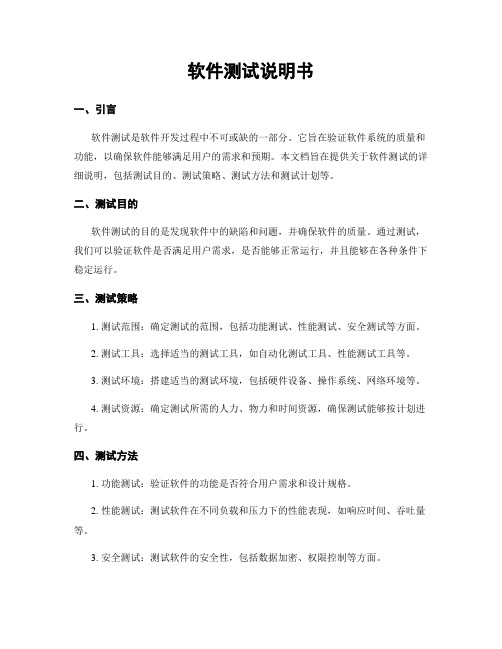
软件测试说明书一、引言软件测试是软件开发过程中不可或缺的一部分。
它旨在验证软件系统的质量和功能,以确保软件能够满足用户的需求和预期。
本文档旨在提供关于软件测试的详细说明,包括测试目的、测试策略、测试方法和测试计划等。
二、测试目的软件测试的目的是发现软件中的缺陷和问题,并确保软件的质量。
通过测试,我们可以验证软件是否满足用户需求,是否能够正常运行,并且能够在各种条件下稳定运行。
三、测试策略1. 测试范围:确定测试的范围,包括功能测试、性能测试、安全测试等方面。
2. 测试工具:选择适当的测试工具,如自动化测试工具、性能测试工具等。
3. 测试环境:搭建适当的测试环境,包括硬件设备、操作系统、网络环境等。
4. 测试资源:确定测试所需的人力、物力和时间资源,确保测试能够按计划进行。
四、测试方法1. 功能测试:验证软件的功能是否符合用户需求和设计规格。
2. 性能测试:测试软件在不同负载和压力下的性能表现,如响应时间、吞吐量等。
3. 安全测试:测试软件的安全性,包括数据加密、权限控制等方面。
4. 兼容性测试:测试软件在不同平台、不同浏览器等环境下的兼容性。
5. 自动化测试:使用自动化测试工具进行测试,提高测试效率和准确性。
五、测试计划测试计划是测试工作的指导文件,包括测试目标、测试方法、测试进度和测试资源等。
以下是测试计划的主要内容:1. 测试目标:明确测试的目标和要求。
2. 测试方法:详细描述测试的方法和步骤。
3. 测试进度:制定测试的时间计划和里程碑。
4. 测试资源:确定测试所需的人力、物力和时间资源。
5. 风险评估:评估测试过程中可能遇到的风险,并制定相应的应对措施。
六、测试执行在测试执行阶段,我们将按照测试计划的要求进行测试,并记录测试结果。
测试结果应包括测试用例、测试数据、测试环境和测试日志等。
测试过程中,我们将密切关注软件的稳定性、功能完整性和性能表现,并及时反馈测试结果给开发团队。
七、测试报告测试报告是对测试结果的总结和分析,它应包括以下内容:1. 测试概述:对测试工作的总体情况进行概述。
spirent自动化测试说明书
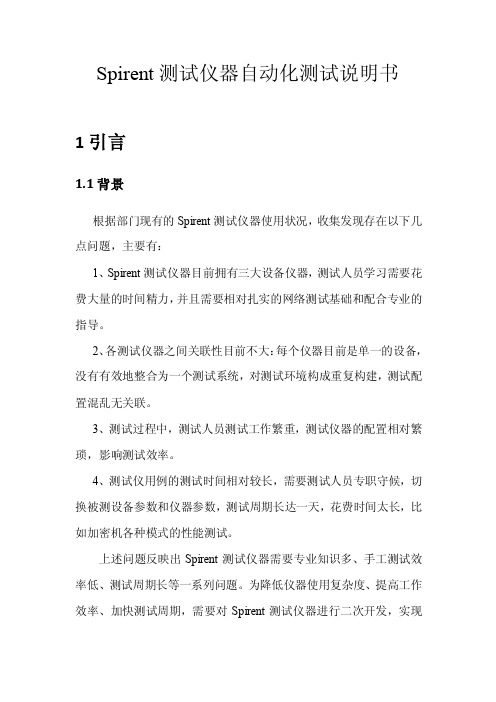
Spirent测试仪器自动化测试说明书1引言1.1背景根据部门现有的Spirent测试仪器使用状况,收集发现存在以下几点问题,主要有:1、Spirent测试仪器目前拥有三大设备仪器,测试人员学习需要花费大量的时间精力,并且需要相对扎实的网络测试基础和配合专业的指导。
2、各测试仪器之间关联性目前不大:每个仪器目前是单一的设备,没有有效地整合为一个测试系统,对测试环境构成重复构建,测试配置混乱无关联。
3、测试过程中,测试人员测试工作繁重,测试仪器的配置相对繁琐,影响测试效率。
4、测试仪用例的测试时间相对较长,需要测试人员专职守候,切换被测设备参数和仪器参数,测试周期长达一天,花费时间太长,比如加密机各种模式的性能测试。
上述问题反映出Spirent测试仪器需要专业知识多、手工测试效率低、测试周期长等一系列问题。
为降低仪器使用复杂度、提高工作效率、加快测试周期,需要对Spirent测试仪器进行二次开发,实现自动化测试,用于代替部分功能繁锁的手工回归测试。
2系统概述2.1系统目标通过对测试仪器的自动化二次开发的目标:对仪器测试接口封装,减少测试参数配置,降低测试仪器的使用复杂度;并可与自动化测试平台结合,更加方便管理、调度、控制测试执行;测试效果和测试结果同GUI模式相同;减少人工值守,加快测试周期,提高测试效率。
2.2功能需求Spirent测试仪器可以通过API支持所有的仪器工作能力。
通过对测试仪器自动化二次开发实现的功能和性能:●降低测试仪器的使用复杂度:简化测试人员的测试工作,其测试仪器简单易用,将测试的工作重心放在对产品的深入测试中。
●缩短测试时间:机器执行可在无人值守的条件下以最快的速度完成测试配置和执行,同时可以与自动化测试平台相结合,进一步减少测试人员的值守和干预。
●提高产品、服务的可靠性:实现回退测试周期的自动化。
确保产品生命周期的每一个阶段中都可以执行完全相同的测试。
●降低学习难度:简便易用的API中融入预先定义的测试逻辑,且无需对RFC2544或者RFC2889测试进行手工编码,从而使生产效率大幅提高。
自动化测试系统顶层设计方法论说明书
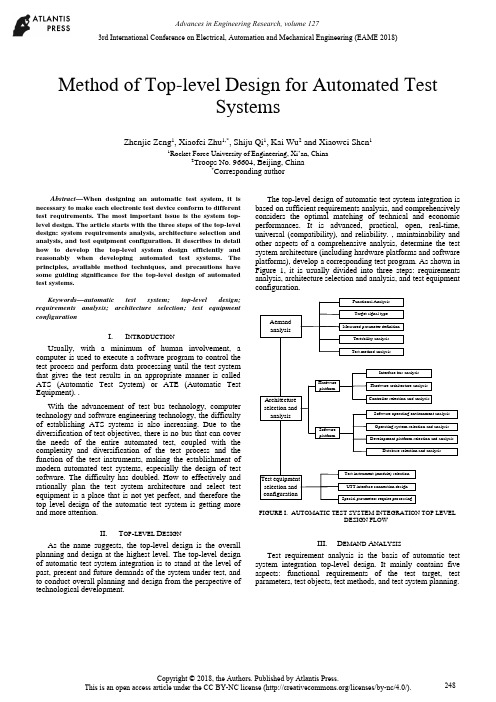
Method of Top-level Design for Automated TestSystemsZhenjie Zeng1, Xiaofei Zhu1,*, Shiju Qi1, Kai Wu2 and Xiaowei Shen11Rocket Force University of Engineering, Xi’an, China2Troops No. 96604, Beijing, China*Corresponding authorAbstract—When designing an automatic test system, it is necessary to make each electronic test device conform to different test requirements. The most important issue is the system top-level design. The article starts with the three steps of the top-level design: system requirements analysis, architecture selection and analysis, and test equipment configuration. It describes in detail how to develop the top-level system design efficiently and reasonably when developing automated test systems. The principles, available method techniques, and precautions have some guiding significance for the top-level design of automated test systems.Keywords—automatic test system; top-level design; requirements analysis; architecture selection; test equipment configurationI.I NTRODUCTIONUsually, with a minimum of human involvement, a computer is used to execute a software program to control the test process and perform data processing until the test system that gives the test results in an appropriate manner is called ATS (Automatic Test System) or ATE (Automatic Test Equipment). .With the advancement of test bus technology, computer technology and software engineering technology, the difficultyof establishing ATS systems is also increasing. Due to the diversification of test objectives, there is no bus that can cover the needs of the entire automated test, coupled with the complexity and diversification of the test process and the function of the test instruments, making the establishment of modern automated test systems, especially the design of test software. The difficulty has doubled. How to effectively and rationally plan the test system architecture and select test equipment is a place that is not yet perfect, and therefore the top level design of the automatic test system is getting more and more attention.II.T OP-LEVEL D ESIGNAs the name suggests, the top-level design is the overall planning and design at the highest level. The top-level design of automatic test system integration is to stand at the level of past, present and future demands of the system under test, and to conduct overall planning and design from the perspective of technological development.The top-level design of automatic test system integration is based on sufficient requirements analysis, and comprehensively considers the optimal matching of technical and economic performances. It is advanced, practical, open, real-time, universal (compatibility), and reliability. , maintainability and other aspects of a comprehensive analysis, determine the test system architecture (including hardware platforms and software platforms), develop a corresponding test program. As shown in Figure 1, it is usually divided into three steps: requirements analysis, architecture selection and analysis, and test equipment configuration.AemandanalysisArchitectureselection andanalysisTest equipmentselection andconfigurationFunctional AnalysisTarget signal typeMeasured parameter definitionTestability analysisTest method analysisInterface bus analysisHardware architecture analysisController selection and analysisHardwareplatformSoftware operating environment analysisOperating system selection and analysisDevelopment platform selection and analysisDatabase selection and analysisTest instrument (module) selectionUTT interface connection designSpecial parameters require processingSoftwareplatformFIGURE I. AUTOMATIC TEST SYSTEM INTEGRATION TOP LEVELDESIGN FLOWIII.D EMAND A NALYSISTest requirement analysis is the basis of automatic test system integration top-level design. It mainly contains five aspects: functional requirements of the test target, test parameters, test objects, test methods, and test system planning.3rd International Conference on Electrical, Automation and Mechanical Engineering (EAME 2018)A.Test Target Functional RequirementsThe different requirements of the test equipment working platform determine the test speed requirements, and also determine the different requirements of the online/offline test; the main control method and logic of the tested equipment determines the difference between the test procedures and methods; the input frequency of the tested equipment, Different parameters, such as amplitude and modulation method, determine the overall requirements for the operating frequency band, small signal level (minimum leakage), and waveform parameters of the automatic test system analog signal source; the output and content of the device under test determines the signal sampling of the automatic test system. The data acquisition method is different; the digital communication interface of the device under test determines that the digital communication interface that the automatic test system should have is different from the protocol; the testability interface of the device under test determines the final test capability and fault diagnosis ability of the automatic test system.B.Test ParametersThe test parameter analysis includes analysis: the form of the measured parameter (electrical or non-electrical, digital or analog, etc.), range and quantity; performance index (measurement accuracy and speed, etc.); the form and range of the excitation signal. In particular, when analyzing requirements for a top-level design of a general-purpose comprehensive automatic test system that is suitable for multiple systems, multiple protocols, and multiple equipment, comprehensive analysis is often required to integrate the test parameters.C.Test ObjectThe test objects vary widely. When analyzing the test objects, a comprehensive analysis must be performed in conjunction with the test system requirements of the test objects. In the face of a specific test object test system or subsystem, the description can use a variety of expressions to give different models of the test system at different levels of simplification, such as language descriptions, graphics, and mathematical formulas. As a simplified description of some test systems, their models merely express their basic characteristics, often ignoring irrelevant details in order to simplify their complexity. For a complex test object test system, a model is inevitably limited by some assumptions in its design and utility. These conditions often have some ambiguity and basically reflect an implicit conceptual idea. Therefore, when analyzing the requirements of a specific test object, it is usually necessary to establish a corresponding test system model.D.Test MethodsAccording to the functional requirements of the test target, a corresponding test method is formulated for the “face-to-face automatic test system” or “object-oriented automatic test system”.. E.Test System PlanningWhen developing an automated test system, it often takes a lot of time to complete the test-assisted tasks such as creating files and programming supporting test software. The test application software development platform can standardize all kinds of test processes and integrate an operating system that is suitable for various test and post-processing functions. It can help us to complete these test auxiliary work; therefore, we use this kind of test platform to conduct various tests. When testing, you can save a lot of time.IV.A RCHITECTURE S ELECTION AND A NALYSIS On the basis of sufficient requirements analysis, determining the architecture of the automated test system is the most critical step in the top-level design. That is how to determine the test plan from the perspective of the top-level design, and select the hardware platform and software platform architecture of the automatic test system, and the most important one is the selection of the test equipment digital communication interface bus.A.System Test Plan SelectionThe system test plan is the overall concept of product testing. It specifies the type of product testing, when (continuous or regular) testing, where (field or workshop, or which maintenance level), testing methods, and test methods used. The types of system test can be divided into: system-wide test and departmental system test, static test and dynamic test, online test and offline test, quantitative test and qualitative test, continuous test and periodic test, etc. The test level can be divided into three levels according to the location: production site, use site, and maintenance base. The test system (equipment) operating methods are generally:According to the use of the operation can be divided into three kinds of automatic, semi-automatic and artificial; according to the general degree of application can be divided into two kinds of special and general equipment; according to the association with the product can be divided into two kinds of BITE and external test equipment.Most of the test methods used in automated testing have so far been modeled on manual tests, from the measurement principles used, the testing techniques used, to the test procedures performed, except that computers were used instead of manual operations. As far as the characteristics and potential of automatic testing are concerned, fundamental reforms of the test plan are needed for future research.B.Selection of Test Equipment Digital CommunicationInterface Bus and ATS StructureThe development of automatic test systems has promoted the continuous emergence of various general-purpose test equipment interface buses and rapid technological advancement: from the early GPIB, CAMAC to the recent VXI, MXI, PCI, PCIe, PXI, PXIe, cPCI, MMS, IEEE1394 ( Firewire), USB, etc. Although technical characteristics are not the same, they are widely used.The structural elements of a modern automated test system are programmable test instruments, test controllers, interconnected standard digital interfaces, and software systems. At present, modern automatic testing has been widely used, and the test objects faced are large, complex, and diversified, making it impossible for an automatic test system based on any kind of bus technology to cover the needs of the entire test object.Multi-bus fusion automatic test system structure shown in Figure 2. It consists of test instruments, DUTs(design under test) and UUT(unit under test) interfaces, test controllers (computers), various general-purpose digital interface buses, and test software. The test controller is interconnected with the test instrument through the digital interface bus, and the device under test is connected to the input/output terminal of the test instrument through the UUT interface. The digital interface bus used may be GPIB, VXI, PXI, LXI, or even an internal computer bus (AT/EISA/PCI), or their convergence. Once the standard digital interface bus architecture used is determined, the automatic test system architecture is basically selected. In an automatic test system, regardless of the interface bus architecture, an external computer or built-in computer system can be selected as the test system controller. The choice of the test system controller should fully consider the optimal matching of technical and economic performance, and choose from real-time, practical, reliable, flexible and convenient.CAT test hostMaster control computerGPIB instrument PC card typeinstrumentVXIinstrumentPXIinstrumentUUT interfaceUUT……FIGURE II. MULTI-BUS FUSION AUTOMATIC TEST SYSTEMSTRUCTUREC.Test Software Platform Mode SelectionIn modern computer-based automated test systems, hardware is the foundation and software is the soul. Test software has increasingly become the main body of ATS, which determines the advanced nature, reliability, practicality, and real-time performance of the entire automated test system.The automatic test software platform mainly refers to the programming language and software support environment involved in the test application software design. It is an integrated software platform such as a computer operating system, a test programming language, a database software, and a program diagnosis software. The key element is Test programming language. Since the automatic test system was popularized and applied, there have been great developments in testing programming languages from low-level to high-level, to the current test application development environment.V.T EST E QUIPMENT C ONFIGURATION After the system structure of the test system is determined, the next task is to synthesize the test contents according to the requirements analysis, and to match the corresponding test equipment according to the test content requirements. There are three types of optional test equipment: general test equipment, special purpose equipment, and test interface adapter.A.Universal Test EquipmentThe universal test equipment includes a main box, a test controller, a main control interface, a zero slot controller, an instrument module, and a desktop instrument. The following factors should be considered when selecting the type of equipment: (1) The higher the degree of equipment automation, the shorter the time for detecting and isolating faults, and the less the manpower consumption, but the cost of test equipment will increase and more protection is needed. (2) Differences in capabilities between the two are to be considered when selecting a BIT (Built-in-Test) and an off-board automatic test equipment. (3) When the BIT is used in conjunction with the off-board automatic test, make full use of the BIT capability of each unit under test. (4) When selecting a dedicated or general-purpose device, it is necessary to consider that the special-purpose device is simple and convenient to use and has high efficiency, but the use range is narrow. (5) The main selection of instrument and equipment is based on the requirements of test parameters, characteristics of the signal to be measured, and range selection. When selecting the instrument module, pay attention to the size of the bus module, power, and number of slots.B.Special Purpose EquipmentWhen the test is not ready for selection, in addition to the above-mentioned common tests, when preparing for the following situations, it may be considered to develop or develop special purpose instrument (module) equipment. When the current product can not meet the test requirements, multiple instruments and equipments are required to complete the measurement together. However, the utilization rate of each instrument is very low or can be accomplished with one instrument. When the price is high and the utilization rate is low, the use of development or development is considered. Special purpose instrument.C.Test Interface Adapter DesignFor different test objects, the extraction and feeding of various test signals requires the design and manufacture of various test interfaces and special fixtures. In the automatic test system, especially the automatic test system assembly of complex electronic equipment, the requirements of the same type but different models and different test objects existuniversally, and often require the test system group to build a relatively universal automatic test platform. Through this platform, different test modules and test methods can be used to quickly and easily complete the automatic test system set-up (configuration) task for different test objects; however, the test interface and the dedicated test module cannot be matched and can only be tested according to the device under test. The test requires the development of a test interface adapter.VI.C ONCLUSIONThis article starts with the three steps of the top-level design: system requirements analysis, architecture selection and analysis, and test equipment configuration. It describes in detail how to perform top-level design efficiently and reasonably when developing automated test systems, and analyzes what the design must follow. Principles, methods, techniques, and precautions have certain guiding significance for the top-level design of automated test systems.R EFERENCES[1]LI Xing-shan, ZUO Yi, SUN Jie. Automatic Test System IntegrationTechnology[M]. Publishing House of Electronics Industry, 2004.[2]QIN Hong-lei, LU Hui et al. Automatic Test System. Beijing: HigherEducation Press, 2007[3]LIU Si-jiu, ZHANG Li-yong. Automatic Test System and VirtualInstrument. Beijing: Publishing House of Electronics Industry, 2009 [4]GU Zhi-yong, TENG Peng, HU Shi-guo, et al. Top-level design of ATSoverall plan for integrated helicopter display systems[J]. Electro-optics and Control, 2008, 15(11):59-62.[5]GU Ya-ping. Research on Top Design of VXI Bus TestingTechnology[J]. Electronic Testing, 1998(8):22-23.。
自动化测试计划

自动化测试计划一、背景。
随着软件开发的不断发展,自动化测试在软件测试领域中扮演着越来越重要的角色。
自动化测试可以提高测试效率、降低测试成本,同时也可以增强测试的准确性和可靠性。
因此,制定一份完善的自动化测试计划对于软件开发团队来说至关重要。
二、目标。
本自动化测试计划的目标是确保软件质量,提高测试效率,降低测试成本,减少人工测试的工作量,增强测试的准确性和可靠性。
三、范围。
本自动化测试计划适用于公司软件开发项目的自动化测试工作,包括但不限于功能测试、性能测试、安全测试等方面。
四、测试工具。
我们将采用Selenium WebDriver作为自动化测试工具,结合JUnit或TestNG作为测试框架,使用Java语言进行脚本编写。
同时,我们将使用Jenkins作为持续集成工具,实现自动化测试的持续执行和报告生成。
五、测试环境。
我们将建立专门的测试环境,包括测试服务器、测试数据库、测试数据等,以确保自动化测试的可靠性和稳定性。
同时,我们将在不同的操作系统和浏览器上进行测试,以保证软件在不同环境下的兼容性。
六、测试用例设计。
我们将根据需求文档和功能规格说明书编写自动化测试用例,确保覆盖软件的各项功能和业务流程。
同时,我们将注重测试用例的可维护性和可重用性,以便后续的测试工作。
七、测试执行。
我们将在每个版本发布前执行自动化测试,及时发现和修复软件中的缺陷。
同时,我们将建立持续集成环境,实现自动化测试的持续执行和结果反馈,确保软件质量的稳定和可靠。
八、测试报告。
我们将生成详细的测试报告,包括测试执行结果、缺陷统计、测试覆盖率等信息,以便开发团队和管理团队及时了解软件的测试情况,做出相应的决策。
九、风险管理。
我们将针对自动化测试过程中可能出现的风险进行评估和管理,确保自动化测试工作的顺利进行。
十、总结。
制定一份完善的自动化测试计划对于软件开发团队来说至关重要。
通过本自动化测试计划的实施,我们将提高测试效率,降低测试成本,减少人工测试的工作量,增强测试的准确性和可靠性,从而确保软件质量和用户体验。
软件测试方案模板(含使用说明)
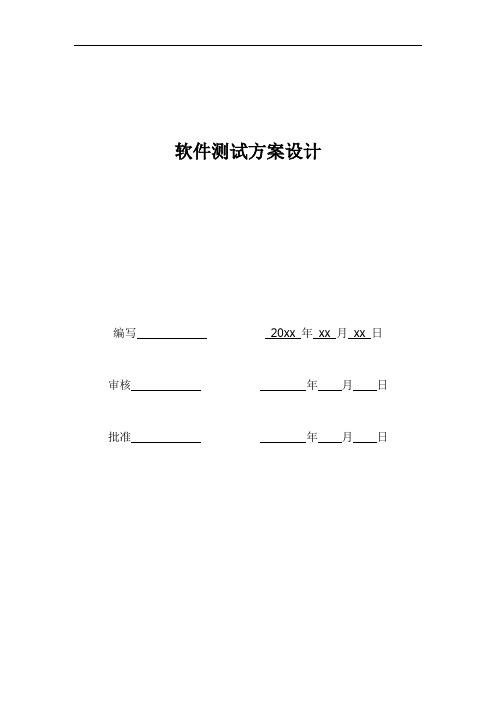
软件测试方案设计编写20xx 年xx 月xx 日审核年月日批准年月日版本控制注:(A-添加,M-修改,D-删除)目录1 概述 (4)1.1 编写目的 (4)1.2 读者对象 (4)1.3 项目背景 (4)1.4 测试目标 (4)1.5 参考资料 (4)2 测试配置要 (4)2.1 测试手段 (4)2.2 测试数据 (5)2.3 测试策略 (5)2.4. 测试通过准则 (6)3 软件结构介绍 (6)3.1 概述 (6)3.2 整体功能模块介绍 (6)3.3 整体功能模块关系图 (6)3.4 系统外部接口功能模块关系图 (7)3.5 系统内部接口功能模块关系图 (7)4 系统测试用例 (7)4.1 XX系统 (7)4.1.1 用户界面 (7)4.1.2 功能测试 (8)7 附录 (8)7.1 附录1 审批记录表 (8)角色 (8)签名 (8)日期 (8)备注 (8)说明:蓝色说明文字,文档编写完成后,请删除。
1 概述1.1 编写目的编写本测试方案的目的是为软件开发项目管理者、软件工程师、系统维护工程师、测试工程师提供关于**系统整体系统功能和性能的测试指导。
1.2 读者对象本测试方案可能的合法读者对象为软件开发项目管理者、软件工程师、测试组、系统维护工程师1.3 项目背景简单说明,根据项目的具体情况,方案编写者也可以进行详细说明1.4 测试目标说明进行项目测试的目标或所要达到的目的1.5 参考资料列出编写本测试方案时参考的资料和文献2 测试配置要2.1 测试手段在此参照《测试计划》说明测试方法和工具,注明执行测试时,必须同时填写《测试记录表》2.2 测试数据在此简要说明测试数据的形成,如以客户单位具体的业务规则和《***系统需求分析说明书》,参考《***系统概要设计说明书》、《***系统详细设计说明书》和《数据规格说明书》中规定的运行限制,设计测试用例,作为整个**系统的测试数据。
2.3 测试策略在此说明测试策略,可以如下这样说明:A)系统测试系统测试目的是在于验证软件的功能和性能及其他特性是否与用户的要求一致,主要是下列类型的测试:1)用户界面测试:测试用户界面是否具有导航性、美观性、行业或公司的规范性、是否满足设计中要求的执行功能。
软件系统测试作业指导书

软件系统测试作业指导书第1章软件测试基础 (4)1.1 软件测试概念 (4)1.2 软件测试目的和意义 (4)1.3 软件测试分类 (4)第2章软件测试过程 (5)2.1 测试计划 (5)2.1.1 目的与范围 (5)2.1.2 测试策略 (5)2.1.3 测试资源 (5)2.1.4 测试进度安排 (5)2.1.5 风险评估与应对措施 (6)2.2 测试设计 (6)2.2.1 测试需求分析 (6)2.2.2 测试用例设计 (6)2.2.3 测试数据准备 (6)2.2.4 测试环境搭建 (6)2.3 测试执行 (6)2.3.1 测试用例执行 (6)2.3.2 缺陷报告 (6)2.3.3 测试结果记录 (6)2.4 缺陷跟踪 (6)2.4.1 缺陷分类与优先级 (6)2.4.2 缺陷生命周期管理 (6)2.4.3 缺陷跟踪工具 (7)2.4.4 缺陷分析 (7)第3章单元测试 (7)3.1 单元测试概述 (7)3.2 单元测试方法 (7)3.2.1 白盒测试 (7)3.2.2 黑盒测试 (7)3.3 单元测试工具 (8)第4章集成测试 (8)4.1 集成测试概述 (8)4.2 集成测试策略 (8)4.3 集成测试用例设计 (9)第5章系统测试 (9)5.1 系统测试概述 (9)5.2 功能测试 (9)5.2.1 目的 (9)5.2.2 测试内容 (9)5.2.3 测试方法 (10)5.3.1 目的 (10)5.3.2 测试内容 (10)5.3.3 测试方法 (10)5.4 安全测试 (10)5.4.1 目的 (10)5.4.2 测试内容 (10)5.4.3 测试方法 (11)第6章验收测试 (11)6.1 验收测试概述 (11)6.1.1 验收测试概念 (11)6.1.2 验收测试目的 (11)6.1.3 验收测试范围 (11)6.1.4 验收测试执行主体 (11)6.2 验收测试方法 (12)6.2.1 功能测试 (12)6.2.2 非功能测试 (12)6.2.3 用户场景测试 (12)6.2.4 回归测试 (13)6.3 验收测试用例设计 (13)6.3.1 功能测试用例设计 (13)6.3.2 非功能测试用例设计 (13)6.3.3 用户场景测试用例设计 (13)6.3.4 回归测试用例设计 (13)第7章回归测试 (14)7.1 回归测试概述 (14)7.1.1 基本概念 (14)7.1.2 目的 (14)7.1.3 重要性 (14)7.2 回归测试策略 (14)7.2.1 全量回归测试 (14)7.2.2 增量回归测试 (14)7.2.3 差异化回归测试 (15)7.3 回归测试用例选取 (15)第8章自动化测试 (15)8.1 自动化测试概述 (15)8.1.1 自动化测试概念 (15)8.1.2 自动化测试分类 (15)8.1.3 自动化测试应用场景 (16)8.2 自动化测试工具 (16)8.2.1 Selenium (16)8.2.2 JMeter (16)8.2.3 Appium (16)8.3 自动化测试框架 (17)8.3.2 Cucumber (17)8.3.3 Robot Framework (17)8.3.4 Jenkins (17)第9章软件测试管理 (17)9.1 测试团队组织 (17)9.1.1 测试团队构成 (17)9.1.2 测试团队职责 (17)9.1.3 测试团队培训与评估 (18)9.2 测试过程管理 (18)9.2.1 测试计划 (18)9.2.2 测试设计 (18)9.2.3 测试执行 (18)9.2.4 缺陷管理 (18)9.2.5 测试报告 (18)9.3 测试风险管理 (18)9.3.1 风险识别 (18)9.3.2 风险评估 (18)9.3.3 风险应对 (18)9.3.4 风险监控 (19)第10章软件测试案例与实践 (19)10.1 软件测试案例概述 (19)10.1.1 测试案例定义 (19)10.1.2 测试案例的重要性 (19)10.1.3 测试案例的分类 (19)10.1.4 测试案例的组成部分 (19)10.2 软件测试案例设计方法 (19)10.2.1 黑盒测试案例设计方法 (19)10.2.2 白盒测试案例设计方法 (19)10.2.3 灰盒测试案例设计方法 (19)10.2.4 静态测试案例设计方法 (19)10.2.5 动态测试案例设计方法 (19)10.2.6 基于风险的测试案例设计方法 (19)10.3 软件测试案例实施与总结 (19)10.3.1 测试环境搭建 (19)10.3.2 测试数据准备 (19)10.3.3 测试执行与记录 (19)10.3.4 缺陷跟踪与管理 (19)10.3.5 测试结果分析 (19)10.3.6 测试总结报告 (19)10.3.7 测试案例迭代与优化 (19)第1章软件测试基础1.1 软件测试概念软件测试是指在软件开发生命周期的各个阶段,依据规定的要求和标准,采用适当的测试方法、工具和策略,对软件产品进行评估、验证和确认的活动。
如何设计自动化测试用例

如何设计自动化测试用例在软件工程领域中,软件的功能测试是一个非常重要的环节。
为了确保软件的质量和稳定性,自动化测试已经成为了越来越多企业的必备工具。
然而,如何设计自动化测试用例是一个需要深入思考的问题。
在本篇文章中,我们将从以下几个方面探讨如何设计自动化测试用例:需求分析、测试用例设计原则、用例编写、执行和维护以及优化。
一、需求分析在设计自动化测试用例之前,首先需要进行需求分析。
需求分析一般分为功能需求和非功能需求。
功能需求是软件需要实现的具体功能要求,非功能需求包括性能、稳定性、安全性等方面的要求。
为了准确地设计自动化测试用例,我们需要对功能需求和非功能需求进行深入的分析和理解。
只有明确了需求,才能确保设计出的测试用例具有准确性和完整性。
二、测试用例设计原则在设计自动化测试用例时,有一些基本的设计原则是需要遵循的。
首先,测试用例应该覆盖尽可能多的场景和情况。
其次,测试用例应该具有可重复性,即可以重复运行得出相同的结果。
第三,测试用例应该具有独立性,即一个测试用例的执行结果不会影响其他测试用例的执行结果。
第四,测试用例应该具有正确性和准确性,符合需求规格说明书的要求。
三、用例编写在设计自动化测试用例时,需要将测试场景转换为测试用例,即根据需求和设计原则编写测试用例。
编写测试用例可以使用各种测试工具,如Selenium、Appium、Robot Framework等。
在编写测试用例时,需要按照设计原则进行,尽可能地覆盖各种可能的情况和场景,进行代码重复性的测试等。
此外,还需要注意测试用例的规范化,即遵循一定的表达格式,包括测试名称、测试步骤、期望结果等方面。
四、执行和维护在设计自动化测试用例后,还需要进行执行和维护。
执行测试用例时,需要选择测试执行环境、测试数据输入、测试结果输出等。
同时,在测试完成之前需要对环境进行清理和初始化,以确保每个测试执行的环境是相同的。
测试用例的维护问题也非常重要,需要在每个版本发布之前进行测试用例的更新和修改,以保证测试用例的有效性和可用性。
ONLLY 系列计算机自动化测试调试(继电保护和计量)系统 说明书

ONLLY®昂立电气世界是相同的,不同的是掌握它的方法时间是相同的,不同的是使用它的效率资源是相同的,不同的是我更善于整合电力是相同的,不同的是它不能储存保护是相同的,不同的是绝大部分时间都处于等待测试是相同的,不同的是始终只与您同时工作尊敬的用户:感谢您使用ONLLY系列计算机自动化测试调试(继电保护和计量)系统,希望本手册能够为您对本公司产品的熟悉和使用提供尽可能详细的帮助信息。
如果仍有未尽之处,或者您需要其他的技术支持和服务,欢迎致电:020-******** 87667331 电力微波:97-3218414也可以访问: 或发E_mail:onllymichael@ onllysimple@企业QQ:199869664 MSN:onllymichael@广州昂立(ONLLY)电气公司广州新普(SIMPLE)电气公司附:本手册适用于ONLLY和SIMPLE品牌的全系列产品,其中包括:A系列(型号:A430 A460 A660 A860)G系列(型号:6108G 4350G 4630G 6630G)以及即将面世的D系列全数字化产品和广州新普(SIMPLE)电气公司生产的A310、A320“准三相计算机自动化测试调试(继电保护和计量)系统”以上产品均为内嵌计算机一体化装置,为便于使用和避免重复,本手册以A460为标准编写,并适用于其余所有型号产品(细节局部略有不同);如果软件升级和更新,增加和更新的内容和功能说明将随最新版本一并发布,您随时可以借助IT网络时代以第一时间获得。
ONLLY®昂立电气声明在保证不影响产品性能和用户使用的情况下,昂立保留改进本手册所有参数的权力,手册中的画面可能有所改变,请以实际画面和实体为准,恕不另行通知。
版权ONLLY®商标为昂立(广州)电气所有,已经在中华人民共和国登记注册(第9类测量仪器设备注册号:1384458);ONLLY系列计算机自动化测试调试( 继电保护)系统的测试软件,已经在中华人民共和国登记软件版权(登记号:2000SR0536),所有权归昂立(广州)电气。
自动化测试方案
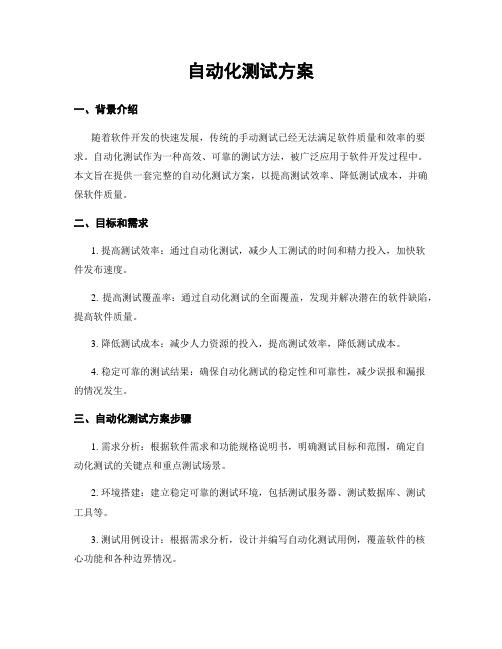
自动化测试方案一、背景介绍随着软件开发的快速发展,传统的手动测试已经无法满足软件质量和效率的要求。
自动化测试作为一种高效、可靠的测试方法,被广泛应用于软件开发过程中。
本文旨在提供一套完整的自动化测试方案,以提高测试效率、降低测试成本,并确保软件质量。
二、目标和需求1. 提高测试效率:通过自动化测试,减少人工测试的时间和精力投入,加快软件发布速度。
2. 提高测试覆盖率:通过自动化测试的全面覆盖,发现并解决潜在的软件缺陷,提高软件质量。
3. 降低测试成本:减少人力资源的投入,提高测试效率,降低测试成本。
4. 稳定可靠的测试结果:确保自动化测试的稳定性和可靠性,减少误报和漏报的情况发生。
三、自动化测试方案步骤1. 需求分析:根据软件需求和功能规格说明书,明确测试目标和范围,确定自动化测试的关键点和重点测试场景。
2. 环境搭建:建立稳定可靠的测试环境,包括测试服务器、测试数据库、测试工具等。
3. 测试用例设计:根据需求分析,设计并编写自动化测试用例,覆盖软件的核心功能和各种边界情况。
4. 自动化脚本开发:根据测试用例,使用合适的自动化测试工具(如Selenium、Appium等),开发自动化测试脚本。
5. 脚本调试和优化:对开发好的自动化测试脚本进行调试和优化,确保脚本的稳定性和可靠性。
6. 执行自动化测试:执行自动化测试脚本,生成测试报告,并对测试结果进行分析和评估。
7. 缺陷管理:对发现的缺陷进行记录、跟踪和管理,并与开发团队进行沟通和协调,确保缺陷得到及时修复。
8. 定期维护和更新:定期对自动化测试脚本进行维护和更新,适应软件的变化和新需求。
四、自动化测试工具推荐1. Selenium:用于Web应用程序的自动化测试,支持多种浏览器和多种编程语言。
2. Appium:用于移动应用程序的自动化测试,支持iOS和Android平台。
3. JUnit:用于Java应用程序的单元测试框架,支持断言和测试报告生成。
轻松上手——软件测试作业指导书
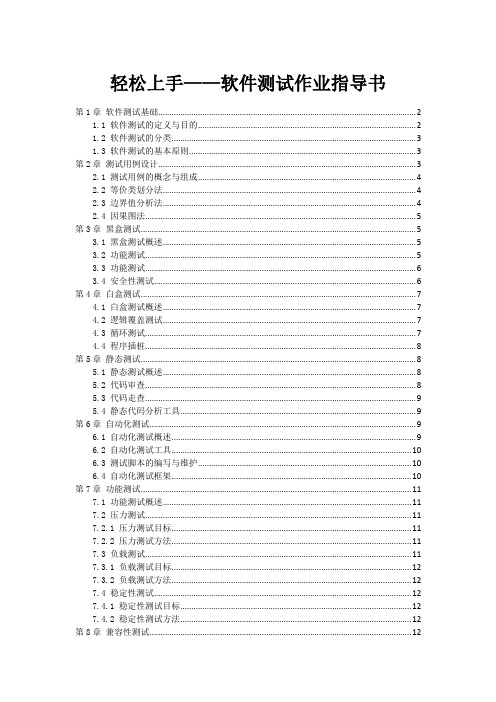
轻松上手——软件测试作业指导书第1章软件测试基础 (2)1.1 软件测试的定义与目的 (2)1.2 软件测试的分类 (3)1.3 软件测试的基本原则 (3)第2章测试用例设计 (3)2.1 测试用例的概念与组成 (4)2.2 等价类划分法 (4)2.3 边界值分析法 (4)2.4 因果图法 (5)第3章黑盒测试 (5)3.1 黑盒测试概述 (5)3.2 功能测试 (5)3.3 功能测试 (6)3.4 安全性测试 (6)第4章白盒测试 (7)4.1 白盒测试概述 (7)4.2 逻辑覆盖测试 (7)4.3 循环测试 (7)4.4 程序插桩 (8)第5章静态测试 (8)5.1 静态测试概述 (8)5.2 代码审查 (8)5.3 代码走查 (9)5.4 静态代码分析工具 (9)第6章自动化测试 (9)6.1 自动化测试概述 (9)6.2 自动化测试工具 (10)6.3 测试脚本的编写与维护 (10)6.4 自动化测试框架 (10)第7章功能测试 (11)7.1 功能测试概述 (11)7.2 压力测试 (11)7.2.1 压力测试目标 (11)7.2.2 压力测试方法 (11)7.3 负载测试 (11)7.3.1 负载测试目标 (12)7.3.2 负载测试方法 (12)7.4 稳定性测试 (12)7.4.1 稳定性测试目标 (12)7.4.2 稳定性测试方法 (12)第8章兼容性测试 (12)8.1 兼容性测试概述 (12)8.2 浏览器兼容性测试 (12)8.3 操作系统兼容性测试 (13)8.4 移动设备兼容性测试 (13)第9章安全性测试 (13)9.1 安全性测试概述 (13)9.2 静态安全性分析 (14)9.2.1 代码审查 (14)9.2.2 代码度量分析 (14)9.2.3 静态应用程序安全测试(SAST) (14)9.3 动态安全性分析 (14)9.3.1 渗透测试 (14)9.3.2 模糊测试 (14)9.3.3 安全性评估 (14)9.4 漏洞扫描工具 (14)9.4.1 Acunetix (14)9.4.2 Burp Suite (15)9.4.3 OpenVAS (15)第10章测试管理 (15)10.1 测试计划与策略 (15)10.1.1 测试目标 (15)10.1.2 测试范围 (15)10.1.3 测试方法与策略 (15)10.1.4 测试资源与时间表 (15)10.2 测试过程管理 (15)10.2.1 测试用例管理 (15)10.2.2 测试执行 (15)10.2.3 测试监控与控制 (16)10.2.4 测试报告 (16)10.3 缺陷管理 (16)10.3.1 缺陷识别与报告 (16)10.3.2 缺陷跟踪与修复 (16)10.3.3 缺陷分析 (16)10.4 测试团队协作与沟通 (16)10.4.1 团队组织与分工 (16)10.4.2 沟通机制与工具 (16)10.4.3 项目协调与支持 (16)第1章软件测试基础1.1 软件测试的定义与目的软件测试是在规定的条件下,对软件产品进行操作以发觉软件缺陷、验证软件功能、功能等是否满足需求的过程。
TCS3000综合自动化测试仪说明书(硬件)
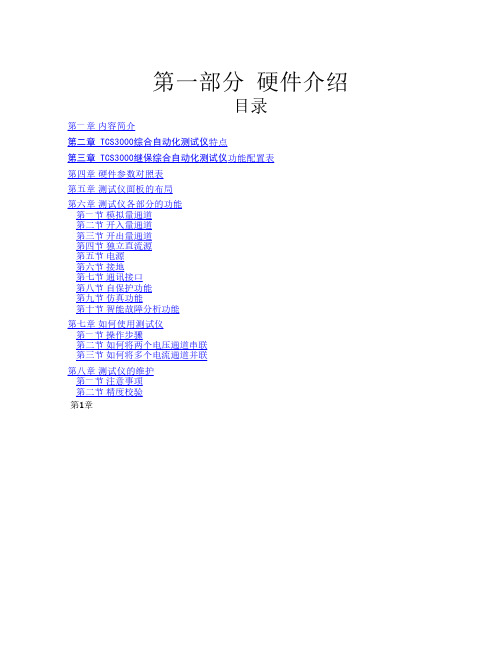
最大输出电 4×125V或2×250V或[1×500V(可选
压
项)]
一、交流电压源
二、交流电流源 三、直流电压 四、直流电流 五、相位
最大输出功 4×75VA或2×150VA或[1×300VA(可选
率
项)]
分辨率
5mV
精度
≤0.1%(5V-110V),≤0.2%(<5V或>110V)
谐波失真 ≤0.1%
各相输出幅值、频率、相位独立可 调,过载自动保护。
最大输出 4×150V或2×300V或[1×600V(可 电压 选项)]
最大输出 4×100W或2×200W或[1×400W(可
三、直流电压 功率
选项)]
精度 ≤0.2%
其它 短路自动保护
最大输出 1×120A 电流
最大输出 1×2500W 四、直流电流 功率
四、直流电流 五、独立辅助直 流电压源 六、相位 七、频率
八、开关量输入
九、开关量输出
其它
各相输出幅值、频率、相位独立可 调,过载自动保护。
最大输出 4×150V或2×300V或[1×600V(可 电压 选项)]
最大输出 4×100W或2×200W或[1×400W(可 功率 选项)]
精度 ≤0.2%
U 盘 接 口
VENUSTC330
√
√
√
√
√
√
√
√
√
√
√
√
√
√
√
√
VENUSTC340
√
√
√
√
√
√
√
√
√
√
√
√
√
√
√
√
软件测试技术手册及规范
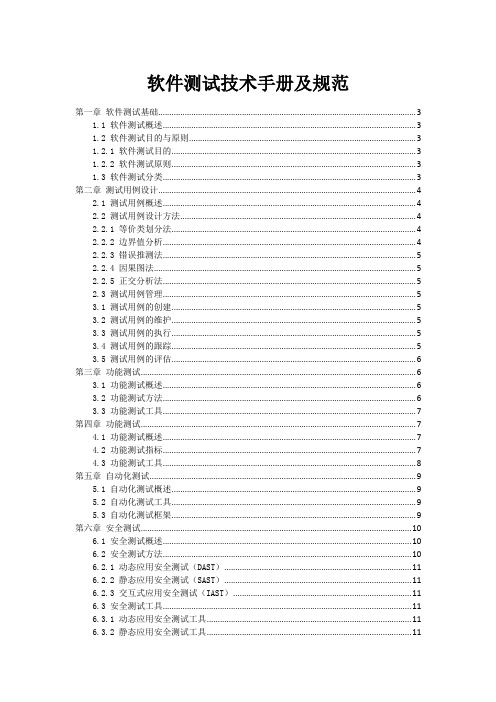
软件测试技术手册及规范第一章软件测试基础 (3)1.1 软件测试概述 (3)1.2 软件测试目的与原则 (3)1.2.1 软件测试目的 (3)1.2.2 软件测试原则 (3)1.3 软件测试分类 (3)第二章测试用例设计 (4)2.1 测试用例概述 (4)2.2 测试用例设计方法 (4)2.2.1 等价类划分法 (4)2.2.2 边界值分析 (4)2.2.3 错误推测法 (5)2.2.4 因果图法 (5)2.2.5 正交分析法 (5)2.3 测试用例管理 (5)3.1 测试用例的创建 (5)3.2 测试用例的维护 (5)3.3 测试用例的执行 (5)3.4 测试用例的跟踪 (5)3.5 测试用例的评估 (6)第三章功能测试 (6)3.1 功能测试概述 (6)3.2 功能测试方法 (6)3.3 功能测试工具 (7)第四章功能测试 (7)4.1 功能测试概述 (7)4.2 功能测试指标 (7)4.3 功能测试工具 (8)第五章自动化测试 (9)5.1 自动化测试概述 (9)5.2 自动化测试工具 (9)5.3 自动化测试框架 (9)第六章安全测试 (10)6.1 安全测试概述 (10)6.2 安全测试方法 (10)6.2.1 动态应用安全测试(DAST) (11)6.2.2 静态应用安全测试(SAST) (11)6.2.3 交互式应用安全测试(IAST) (11)6.3 安全测试工具 (11)6.3.1 动态应用安全测试工具 (11)6.3.2 静态应用安全测试工具 (11)6.3.3 交互式应用安全测试工具 (12)第七章兼容性测试 (12)7.1 兼容性测试概述 (12)7.2 兼容性测试方法 (12)7.3 兼容性测试工具 (13)第八章稳定性与回归测试 (13)8.1 稳定性与回归测试概述 (13)8.2 稳定性与回归测试方法 (13)8.2.1 稳定性测试 (13)8.2.2 回归测试 (14)8.3 稳定性与回归测试工具 (14)第九章测试管理 (15)9.1 测试管理概述 (15)9.2 测试计划与管理 (15)9.3 测试团队管理 (15)第十章缺陷管理 (16)10.1 缺陷管理概述 (16)10.1.1 缺陷的定义 (16)10.1.2 缺陷管理的目的 (16)10.1.3 缺陷管理的内容 (16)10.2 缺陷跟踪与管理 (16)10.2.1 缺陷记录 (17)10.2.2 缺陷跟踪 (17)10.2.3 缺陷统计与分析 (17)10.3 缺陷分析 (17)第十一章测试文档与报告 (18)11.1 测试文档概述 (18)11.1.1 测试文档的定义 (18)11.1.2 测试文档的分类 (18)11.1.3 测试文档的作用 (18)11.2 测试报告撰写 (18)11.2.1 测试报告的定义 (18)11.2.2 测试报告的结构 (18)11.2.3 测试报告撰写要点 (19)11.3 测试报告评审 (19)11.3.1 测试报告评审的目的 (19)11.3.2 测试报告评审的内容 (19)11.3.3 测试报告评审流程 (19)第十二章测试流程与规范 (20)12.1 测试流程概述 (20)12.2 测试流程优化 (20)12.3 测试规范制定与执行 (21)第一章软件测试基础1.1 软件测试概述软件测试是软件开发过程中不可或缺的一个重要环节,它旨在保证软件产品在实际运行过程中能够满足用户的需求,提高软件质量,降低软件缺陷带来的风险。
测试设计方案
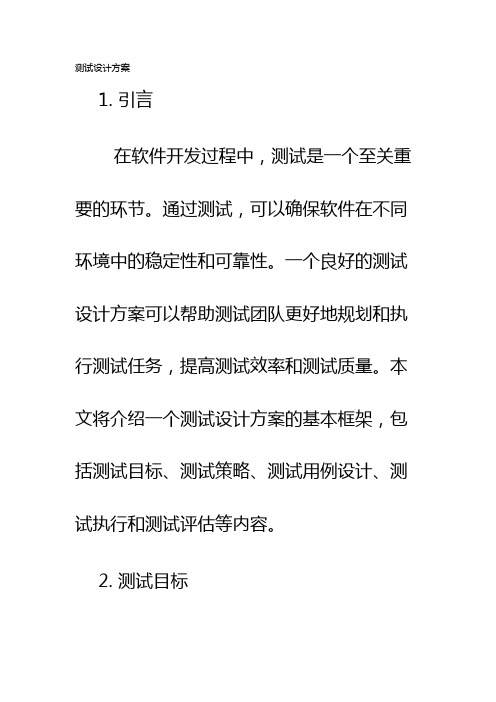
测试设计方案1. 引言在软件开发过程中,测试是一个至关重要的环节。
通过测试,可以确保软件在不同环境中的稳定性和可靠性。
一个良好的测试设计方案可以帮助测试团队更好地规划和执行测试任务,提高测试效率和测试质量。
本文将介绍一个测试设计方案的基本框架,包括测试目标、测试策略、测试用例设计、测试执行和测试评估等内容。
2. 测试目标在开始测试之前,首先需要明确测试的目标。
测试目标可以根据实际需求进行调整,但通常包括以下几个方面:- 功能测试:验证软件的功能是否符合需求规格说明书中的要求。
- 性能测试:测试软件在不同负载和并发情况下的性能表现。
- 安全测试:测试软件是否存在安全漏洞,以及漏洞可能对系统造成的影响。
- 兼容性测试:测试软件在不同平台和浏览器上的兼容性。
- 用户体验测试:测试软件的用户界面是否友好,并对用户体验进行评估。
3. 测试策略测试策略是测试方案的核心部分,它定义了测试的整体框架和方法。
测试策略应包括以下几个方面:- 测试环境:确定测试所需的硬件、软件和网络环境。
- 测试阶段:将测试分为不同的阶段,例如单元测试、集成测试和系统测试等。
- 测试方法:确定测试使用的方法,例如黑盒测试、白盒测试和灰盒测试等。
- 测试工具:选择合适的测试工具,例如自动化测试工具和性能测试工具等。
- 测试资源:分配测试资源,包括人力资源和时间资源等。
- 风险评估:评估测试过程中可能出现的风险,制定相应的应对措施。
4. 测试用例设计测试用例设计是测试方案中的一个重要环节。
通过设计有效的测试用例,可以最大程度地覆盖软件的功能和场景。
测试用例设计应包括以下几个步骤:- 确定测试对象:确定需要测试的功能和模块。
- 划分测试场景:将测试用例划分为不同的场景,包括正常场景、异常场景和边界场景等。
- 设计测试数据:确定测试用例所需的输入数据和预期输出结果。
- 设计测试步骤:根据测试场景和测试数据,设计具体的测试步骤。
- 确定执行顺序:确定测试用例的执行顺序,以最大程度地提高测试效率。
软件自动化测试

软件自动化测试软件自动化测试是一种通过使用自动化工具和脚本来执行软件测试的方法。
它能够提高测试效率,减少测试周期,并提供更准确的测试结果。
本文将详细介绍软件自动化测试的标准格式和相关内容。
一、测试目的软件自动化测试的目的是通过自动化工具和脚本来执行测试活动,以验证软件的功能、性能和稳定性,确保软件质量符合预期。
二、测试范围软件自动化测试的范围包括但不限于以下方面:1. 功能测试:验证软件的各项功能是否按照需求规格说明书的要求正常工作。
2. 性能测试:评估软件在不同负载条件下的性能表现,包括响应时间、吞吐量等指标。
3. 稳定性测试:测试软件在长时间运行或高负载情况下的稳定性和可靠性。
4. 兼容性测试:验证软件在不同操作系统、浏览器和设备上的兼容性。
5. 安全性测试:评估软件的安全性,包括漏洞扫描、权限控制等方面的测试。
三、测试环境软件自动化测试需要准备以下测试环境:1. 硬件环境:包括测试服务器、客户端设备等。
2. 软件环境:包括操作系统、数据库、浏览器等。
3. 自动化工具:选择适合项目需求的自动化测试工具,如Selenium、Appium 等。
4. 测试数据:准备测试所需的数据,包括正常数据、异常数据等。
四、测试步骤软件自动化测试的步骤如下:1. 确定测试目标和范围。
2. 设计测试用例:根据需求规格说明书编写测试用例,并将其转化为自动化脚本。
3. 配置测试环境:搭建测试环境,包括安装操作系统、配置数据库等。
4. 执行测试用例:使用自动化工具执行测试用例,并记录测试结果。
5. 分析测试结果:根据测试结果进行问题定位和分析,查找软件中存在的缺陷或问题。
6. 缺陷管理:将发现的缺陷记录在缺陷管理系统中,并跟踪缺陷的修复过程。
7. 重复执行测试:对修复后的软件再次执行自动化测试,确保问题得到解决。
五、测试报告软件自动化测试的测试报告应包含以下内容:1. 测试概述:对测试范围、测试目标和测试环境进行简要描述。
软件测试流程与方法指导书

软件测试流程与方法指导书第1章软件测试概述 (4)1.1 软件测试的定义与目的 (4)1.2 软件测试的基本概念 (4)1.3 软件测试的发展历程 (4)第2章软件测试生命周期 (4)2.1 测试计划阶段 (4)2.2 测试设计阶段 (4)2.3 测试执行阶段 (4)2.4 测试总结阶段 (4)第3章软件测试方法 (4)3.1 黑盒测试 (4)3.2 白盒测试 (4)3.3 灰盒测试 (4)3.4 静态测试与动态测试 (5)第4章软件测试类型 (5)4.1 单元测试 (5)4.2 集成测试 (5)4.3 系统测试 (5)4.4 验收测试 (5)第5章测试用例设计 (5)5.1 测试用例的组成 (5)5.2 测试用例设计方法 (5)5.3 测试用例的优先级与分类 (5)5.4 测试用例的维护 (5)第6章缺陷管理 (5)6.1 缺陷生命周期 (5)6.2 缺陷报告 (5)6.3 缺陷跟踪与解决 (5)6.4 缺陷分析 (5)第7章自动化测试 (5)7.1 自动化测试概述 (5)7.2 自动化测试工具选择 (5)7.3 自动化测试框架设计 (5)7.4 自动化测试脚本编写 (5)第8章功能测试 (5)8.1 功能测试概述 (5)8.2 功能测试指标 (5)8.3 功能测试方法 (5)8.4 功能测试工具 (5)第9章安全测试 (5)9.1 安全测试概述 (5)9.3 安全测试工具 (6)9.4 安全测试策略 (6)第10章兼容性测试 (6)10.1 兼容性测试概述 (6)10.2 硬件兼容性测试 (6)10.3 软件兼容性测试 (6)10.4 网络兼容性测试 (6)第11章用户体验测试 (6)11.1 用户体验测试概述 (6)11.2 用户体验测试方法 (6)11.3 用户体验测试工具 (6)11.4 用户体验测试流程 (6)第12章软件测试团队与项目管理 (6)12.1 测试团队组织结构 (6)12.2 测试人员职责与技能要求 (6)12.3 软件测试项目管理 (6)12.4 测试过程改进与优化 (6)第1章软件测试概述 (6)1.1 软件测试的定义与目的 (6)1.2 软件测试的基本概念 (7)1.3 软件测试的发展历程 (7)第2章软件测试生命周期 (7)2.1 测试计划阶段 (7)2.2 测试设计阶段 (8)2.3 测试执行阶段 (8)2.4 测试总结阶段 (9)第3章软件测试方法 (9)3.1 黑盒测试 (9)3.1.1 测试方法 (9)3.1.2 应用场景 (10)3.2 白盒测试 (10)3.2.1 测试方法 (10)3.2.2 应用场景 (10)3.3 灰盒测试 (10)3.3.1 测试方法 (10)3.3.2 应用场景 (10)3.4 静态测试与动态测试 (11)3.4.1 静态测试 (11)3.4.2 动态测试 (11)第4章软件测试类型 (11)4.1 单元测试 (11)4.2 集成测试 (12)4.3 系统测试 (12)第5章测试用例设计 (12)5.1 测试用例的组成 (12)5.2 测试用例设计方法 (13)5.3 测试用例的优先级与分类 (13)5.4 测试用例的维护 (14)第6章缺陷管理 (14)6.1 缺陷生命周期 (14)6.1.1 缺陷生命周期的阶段 (14)6.1.2 缺陷状态转换 (15)6.2 缺陷报告 (15)6.2.1 缺陷报告的要素 (15)6.2.2 缺陷报告的撰写规范 (15)6.3 缺陷跟踪与解决 (15)6.3.1 缺陷跟踪 (15)6.3.2 缺陷解决 (15)6.4 缺陷分析 (16)6.4.1 缺陷分布分析 (16)6.4.2 缺陷原因分析 (16)6.4.3 缺陷预防与改进 (16)第7章自动化测试 (16)7.1 自动化测试概述 (16)7.2 自动化测试工具选择 (16)7.3 自动化测试框架设计 (17)7.4 自动化测试脚本编写 (17)第8章功能测试 (17)8.1 功能测试概述 (17)8.2 功能测试指标 (18)8.3 功能测试方法 (18)8.4 功能测试工具 (18)第9章安全测试 (19)9.1 安全测试概述 (19)9.1.1 安全测试的定义 (19)9.1.2 安全测试的意义 (19)9.1.3 安全测试与其他测试类型的区别 (19)9.2 安全测试方法 (19)9.2.1 静态分析 (19)9.2.2 动态分析 (20)9.2.3 渗透测试 (20)9.3 安全测试工具 (20)9.3.1 静态分析工具 (20)9.3.2 动态分析工具 (20)9.3.3 渗透测试工具 (20)9.4 安全测试策略 (20)9.4.2 风险评估 (21)9.4.3 分阶段进行安全测试 (21)9.4.4 结合自动化测试和手工测试 (21)9.4.5 持续安全测试 (21)第10章兼容性测试 (21)10.1 兼容性测试概述 (21)10.2 硬件兼容性测试 (21)10.3 软件兼容性测试 (21)10.4 网络兼容性测试 (22)第11章用户体验测试 (22)11.1 用户体验测试概述 (22)11.2 用户体验测试方法 (22)11.3 用户体验测试工具 (23)11.4 用户体验测试流程 (23)第12章软件测试团队与项目管理 (24)12.1 测试团队组织结构 (24)12.2 测试人员职责与技能要求 (24)12.3 软件测试项目管理 (25)12.4 测试过程改进与优化 (25)以下是软件测试流程与方法指导书的目录结构:第1章软件测试概述1.1 软件测试的定义与目的1.2 软件测试的基本概念1.3 软件测试的发展历程第2章软件测试生命周期2.1 测试计划阶段2.2 测试设计阶段2.3 测试执行阶段2.4 测试总结阶段第3章软件测试方法3.1 黑盒测试3.2 白盒测试3.3 灰盒测试3.4 静态测试与动态测试第4章软件测试类型4.1 单元测试4.2 集成测试4.3 系统测试4.4 验收测试第5章测试用例设计5.1 测试用例的组成5.2 测试用例设计方法5.3 测试用例的优先级与分类5.4 测试用例的维护第6章缺陷管理6.1 缺陷生命周期6.2 缺陷报告6.3 缺陷跟踪与解决6.4 缺陷分析第7章自动化测试7.1 自动化测试概述7.2 自动化测试工具选择7.3 自动化测试框架设计7.4 自动化测试脚本编写第8章功能测试8.1 功能测试概述8.2 功能测试指标8.3 功能测试方法8.4 功能测试工具第9章安全测试9.1 安全测试概述9.2 安全测试方法9.3 安全测试工具9.4 安全测试策略第10章兼容性测试10.1 兼容性测试概述10.2 硬件兼容性测试10.3 软件兼容性测试10.4 网络兼容性测试第11章用户体验测试11.1 用户体验测试概述11.2 用户体验测试方法11.3 用户体验测试工具11.4 用户体验测试流程第12章软件测试团队与项目管理12.1 测试团队组织结构12.2 测试人员职责与技能要求12.3 软件测试项目管理12.4 测试过程改进与优化第1章软件测试概述1.1 软件测试的定义与目的软件测试作为软件开发过程中的重要环节,旨在保证软件产品满足既定需求,并具备高质量、高可靠性和高稳定性。
- 1、下载文档前请自行甄别文档内容的完整性,平台不提供额外的编辑、内容补充、找答案等附加服务。
- 2、"仅部分预览"的文档,不可在线预览部分如存在完整性等问题,可反馈申请退款(可完整预览的文档不适用该条件!)。
- 3、如文档侵犯您的权益,请联系客服反馈,我们会尽快为您处理(人工客服工作时间:9:00-18:30)。
自动化测试基础框架设计说书
本次自动化测试选择的自动化测试框架为BPT自动化测试框架,BPT自动化测试的优点为:
(1)可以轻易的实现目前比较流行的三层测试架构:脚本层,业务层,数据层相分离,为功能自动化测试提供一个高效、稳定、容易的自动化测试平台;
(2)我行自主开发的工具集有效解决了测试数据管理、测试脚本快速生成、界面元素操控、常用外设模拟、测试场景规划等一系列问题;
(3)相关业务人员可以脱离脚本,在QC图形化界面中通过拖拉封装好的脚本组件组织测试案例和串联业务流程进行自动化测试;(4)明确的角色分工,业务人员负责流程的组织,测试数据的录入;
QTP工程师负责脚本的开发、维护。
本项目自动化测试整体框架结构为QC+BPT+QTP+我行自主开
发工具集,框架图如下:
一、三层架构解析
(1)脚本层
脚本封装成一个个独立的组件后更新到QC服务器的Business Components域中。
(2)业务层
业务人员或者测试人员在测试计划中把组件组合成各种测试案例、测试场景、测试流程。
(3)数据层
在BPT架构下,自动化测试数据都存放在QC测试计划的测试案例中,可以一条案例配置一条数据,也可以一条案例配置多条数据,迭代测试。
对于部分交易,测试数据使用一次后,将不能再次使用,如贷款放款交易的借据号,账户销户的账号等,通过消耗型测试数据供给池来解决此问题。
通过重复型数据管理工具,可实现对自动化测试过程中反复使用的不会被耗用的数据进行集中管理,并可实现测试数据在不同测试场景中传递。
二、框架拓扑图
脚本开发机承当自动化脚本开发、维护并实时更新到QC服务器上;
QC服务器作为管理者进行脚本管理、测试案例管理、测试数据管理、安排测试集合并调度脚本执行机进行测试。
脚本执行机承当脚本执行的角色,QC调用脚本执行机QTP的时候会把测试脚本下发给脚本执行机,脚本执行机根据下发的脚本进行相应的自动化测试。
三、框架详细分解图
四、框架运行内部关系图
在自动化执行过程中,是通过组件调用公共函数库、对象库、QC测试数据层、测试数据池、场景恢复库。
